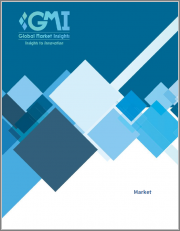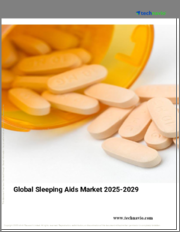
|
시장보고서
상품코드
1382482
세계의 수면제 시장 규모 - 유형별, 약물 유형별, 수면장애 유형별 예측(2023-2032년)Sleep Medications Market Size - By Type (Prescription-based, OTC), Drug Class (Benzodiazepines, Antidepressants, Antihistamines), Sleep Disorder Type, Global Forecast 2023-2032 |
||||||
세계 수면제 시장 규모는 2023년부터 2032년까지 연평균 6.8% 이상 성장할 것으로 예상됩니다.
스트레스 수준 증가와 바쁜 생활방식으로 인해 세계적으로 수면장애의 유병률이 급증하고 있습니다. 노인 인구 증가, 만성 질환의 유병률 증가, 수면 습관의 중요성에 대한 인식이 높아짐에 따라 제품 수요가 증가하고 있습니다.
또한, 좌식 생활 습관과 정신 질환의 높은 유병률은 효과적인 수면제의 채택을 더욱 가속화하여 시장 확대를 촉진하고 있습니다. 하버드 의대와 퀸즐랜드 대학 연구진이 공동으로 주도한 대규모 연구에 따르면 세계 인구의 50%가 75세까지 최소 한 가지 이상의 정신 건강 장애를 앓게 됩니다. 정신 건강 문제가 발전함에 따라 향후 몇 년동안 수면제의 필요성도 증가할 것으로 보입니다.
OTC 의약품 부문은 2023년부터 2032년까지 7.1%의 CAGR을 나타낼 것으로 예상되는데, 그 주된 이유는 접근성이 용이하고 소비자들 사이에서 자가 치료 선호도가 높아졌기 때문입니다. 일반적인 수면장애를 빠르게 완화하는 여러 OTC 수면 보조제가 출시되면서 소비자들은 점점 더 이러한 약품에 관심을 보이고 있으며, OTC 수면제에 대한 수요는 주요 제약사들이 채택한 제품 혁신과 마케팅 전략에 힘입어 지속적으로 증가하고 있습니다.
수면장애(RLSD) 분야는 2023년부터 2032년까지 약 8.4%의 CAGR을 나타낼 것으로 예측됩니다. 이 질환에 대한 대중의 인식이 높아짐에 따라 이 특정 증상을 치료하는 특정 의약품에 대한 수요가 증가하고 있습니다. 시장 참여자들은 효과적인 치료제를 개발하기 위한 연구개발에 적극적으로 나서고 있습니다. 진단 사례 증가와 증상 치료에 초점을 맞춘 새로운 치료 옵션의 개발은 이 분야의 성장을 가속할 것으로 보입니다.
아시아태평양의 수면제 시장은 급속한 도시화, 라이프스타일의 변화, 중국, 인도, 일본 등의 국가에서 수면장애의 유병률 증가로 인해 2023년부터 2032년까지 약 7.9%의 CAGR을 나타낼 것으로 예상됩니다. 이 지역의 의료 인프라가 개선되고 있으며, 수면 건강의 중요성에 대한 인식이 높아짐에 따라 시장 성장의 원동력이 될 것으로 예상됩니다. 제약사들은 아시아태평양 시장에서의 입지를 확대하기 위해 자체 제품을 출시하고 판매망을 강화하여 이 지역의 성장 기회를 활용하는 데 전략적으로 집중하고 있습니다.
목차
제1장 조사 방법과 조사 범위
제2장 주요 요약
제3장 수면제 시장 인사이트
- 업계 상황
- 업계에 대한 영향요인
- 성장 촉진요인
- 업계의 잠재적 리스크&과제
- 성장 가능성 분석
- COVID-19의 영향 분석
- 규제 상황
- Porter's Five Forces 분석
- PESTEL 분석
제4장 경쟁 구도
- 서론
- 기업 매트릭스 분석
- 경쟁 포지셔닝 매트릭스
- 전략 대시보드
제5장 수면제 시장 : 유형별, 2018년-2032년
- 주요 동향 : 유형별
- 처방약 기반
- OTC 의약품
제6장 수면제 시장 : 약제 클래스별, 2018년-2032년
- 주요 동향 : 약제 클래스별
- 벤조디아제핀계
- 항우울제
- 항히스타민제
- 진정성 항정신병 약물
- 기타 약제 클래스별
제7장 수면제 시장 : 수면장애 유형별, 2018년-2032년
- 주요 동향 : 수면장애 별
- 불면증
- 수면무호흡증
- 하지불안 증후군
- 기면증
- 수면 보행
- 기타 수면장애
제8장 수면제 시장 : 지역별, 2018년-2032년
- 주요 동향 : 지역별
- 북미
- 미국
- 캐나다
- 유럽
- 독일
- 영국
- 프랑스
- 스페인
- 이탈리아
- 기타 유럽
- 아시아태평양
- 중국
- 일본
- 인도
- 호주
- 기타 아시아태평양
- 라틴아메리카
- 브라질
- 멕시코
- 기타 라틴아메리카
- 중동 및 아프리카
- 남아프리카공화국
- 사우디아라비아
- 기타 중동 및 아프리카
제9장 기업 개요
- Pfizer Inc.
- Sanofi SA
- Eisai Co., Ltd.
- Sunovion Pharmaceuticals Inc.
- Merck and Co Inc.
- Takeda Pharmaceutical Company Limited
- Johnson & Johnson
- Novartis AG
- Vanda Pharmaceuticals
- Teva Pharmaceuticals
Sleep medications market size is predicted to grow at over 6.8% CAGR from 2023 to 2032. The rising stress levels and hectic lifestyles have led to an upsurge in the prevalence of sleep disorders globally. The growing elderly population, increasing incidences of chronic diseases, along with the improved awareness about the importance of sleep routine are fueling the product demand.
Moreover, the adoption of sedentary lifestyles and the high prevalence of mental health disorders have further accelerated the adoption of effective sleep medications, fostering market expansion. According to a large-scale study co-led by researchers at Harvard Medical School and University of Queensland, 50% of the global population will develop at least one mental health disorder by the age of 75 years. As mental health issues develop, the need for sleep medications will also increase in the coming years.
The overall sleep medications market is classified based on type, drug class, sleep disorder type, and region.
The OTC drug segment is expected to observe 7.1% CAGR from 2023 to 2032, primarily due to the ease of accessibility and the growing preference for self-medication among the consumers. With the introduction of several OTC sleep aids that offer quick relief from common sleep disorders, consumers are increasingly inclined towards these medications. The demand for OTC sleep drugs continue to boost, supported by the product innovations and marketing strategies adopted by leading pharmaceutical companies.
The restless legs sleep disorder (RLSD) segment is anticipated to witness nearly 8.4% CAGR during 2023 and 2032. The rising awareness about the ailment among the common population is leading to an increased demand for specific medications catering to this particular condition. The market players are actively engaged in R&D activities to introduce effective formulations. The increasing number of diagnosed cases and the development of novel treatment options focusing on addressing its symptoms will aid the segment growth.
Asia Pacific sleep medication market will observe around 7.9% CAGR from 2023 to 2032 owing to the rapid urbanization, changing lifestyle patterns, and the increasing prevalence of sleep disorders in countries such as China, India, and Japan. The region is witnessing improvement in healthcare infrastructure, which along with the rising awareness about the importance of sleep health is expected to drive the market growth. The pharma companies are strategically focusing on expanding their presence in the Asia Pacific market by launching tailored products and strengthening distribution networks, thereby capitalizing on the growing opportunities in this region.
Table of Contents
Chapter 1 Methodology & Scope
- 1.1 Market definition
- 1.2 Base estimates & calculations
- 1.3 Forecast calculation
- 1.4 Covid-19 impact analysis at global level
- 1.5 Data validation
- 1.6 Data sources
- 1.6.1 Secondary
- 1.6.1.1 Paid sources
- 1.6.1.2 Public sources
- 1.6.2 Primary
- 1.6.1 Secondary
Chapter 2 Executive Summary
- 2.1 Sleep medications industry 360 degree synopsis, 2018 - 2032 (USD Million)
- 2.1.1 Business trends
- 2.1.2 Regional trends
- 2.1.3 Type trends
- 2.1.4 Drug class trends
- 2.1.5 Sleep disorder type trends
Chapter 3 Sleep Medications Market Insights
- 3.1 Industry landscape, 2018 - 2032 (USD Million)
- 3.2 Industry impact forces
- 3.2.1 Growth drivers
- 3.2.1.1 Increasing prevalence of sleep disorders
- 3.2.1.2 Stressful lifestyles of people
- 3.2.1.3 Advancements in drug development
- 3.2.1.4 Growth in aging population across the globe
- 3.2.2 Industry pitfalls & challenges
- 3.2.2.1 Side effects associated with sleeping medications
- 3.2.2.2 Availability of alternative Therapies
- 3.2.2.3 Limited insurance coverage for sleep medications
- 3.2.1 Growth drivers
- 3.3 Growth potential analysis
- 3.3.1 By type
- 3.3.2 By drug class
- 3.3.3 By sleep disorder type
- 3.4 COVID-19 impact analysis
- 3.5 Regulatory landscape
- 3.6 Porter's analysis
- 3.7 PESTEL analysis
Chapter 4 Competitive Landscape, 2022
- 4.1 Introduction
- 4.2 Company matrix analysis, 2022
- 4.3 Competitive positioning matrix, 2022
- 4.4 Strategic dashboard, 2022
Chapter 5 Sleep Medications Market, By Type, 2018 - 2032 (USD Million)
- 5.1 Key trends, by type
- 5.2 Prescription-based drugs
- 5.3 OTC drugs
Chapter 6 Sleep Medications Market, By Drug Class, 2018 - 2032 (USD Million)
- 6.1 Key trends, by drug class
- 6.2 Benzodiazepines
- 6.3 Antidepressants
- 6.4 Antihistamines
- 6.5 Sedating antipsychotics
- 6.6 Other drug classes
Chapter 7 Sleep Medications Market, By Sleep Disorder Type, 2018 - 2032 (USD Million)
- 7.1 Key trends, by sleep disorder
- 7.2 Insomnia
- 7.3 Sleep apnea
- 7.4 Restless legs syndrome
- 7.5 Narcolepsy
- 7.6 Sleep walking
- 7.7 Other sleep disorders
Chapter 8 Sleep Medications Market, By Region, 2018 - 2032 (USD Million)
- 8.1 Key trends, by region
- 8.2 North America
- 8.2.1 U.S.
- 8.2.2 Canada
- 8.3 Europe
- 8.3.1 Germany
- 8.3.2 UK
- 8.3.3 France
- 8.3.4 Spain
- 8.3.5 Italy
- 8.3.6 Rest of Europe
- 8.4 Asia Pacific
- 8.4.1 China
- 8.4.2 Japan
- 8.4.3 India
- 8.4.4 Australia
- 8.4.5 Rest of Asia Pacific
- 8.5 Latin America
- 8.5.1 Brazil
- 8.5.2 Mexico
- 8.5.3 Rest of Latin America
- 8.6 Middle East & Africa
- 8.6.1 South Africa
- 8.6.2 Saudi Arabia
- 8.6.3 Rest of Middle East & Africa
Chapter 9 Company Profiles
- 9.1 Pfizer Inc.
- 9.2 Sanofi SA
- 9.3 Eisai Co., Ltd.
- 9.4 Sunovion Pharmaceuticals Inc.
- 9.5 Merck and Co Inc.
- 9.6 Takeda Pharmaceutical Company Limited
- 9.7 Johnson & Johnson
- 9.8 Novartis AG
- 9.9 Vanda Pharmaceuticals
- 9.10 Teva Pharmaceuticals



















